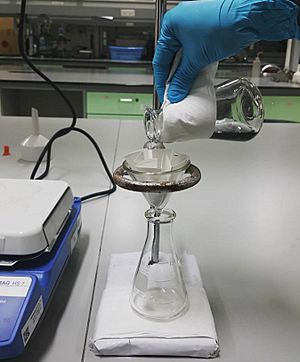Separation process facts for kids
A separation process is a way to split a mixture into two or more different substances. Imagine you have a bowl of cereal and milk; that's a mixture! A separation process would be like trying to get the cereal back out of the milk. Scientists and even you use these methods all the time. The best way to separate things depends on what the mixture is made of and what its parts are like.
Contents
What is a Separation Process?
A separation process is a special method used to take apart a mixture. A mixture is when two or more things are combined but not chemically joined. Think of sand and water, or salt dissolved in water. Each part of the mixture keeps its own properties. When you separate them, you get back the original, pure substances.
Why Do We Separate Things?
We separate mixtures for many reasons. Sometimes, we want to get a pure substance from a mixture. For example, we might want pure salt from salty water. Other times, we need to remove something harmful or unwanted. Imagine cleaning dirty water to make it safe to drink. Separation processes are also important for recycling, like separating plastics from paper.
How Do We Separate Mixtures?
There are many different ways to separate mixtures. Each method works best for certain types of mixtures. Here are some common examples:
Filtration: Catching Solids
Filtration is like using a sieve or a coffee filter. It separates solid particles from a liquid or a gas. The mixture passes through a filter that has tiny holes. The liquid or gas goes through, but the solid particles are too big and get caught.
- Example: Making coffee, where the coffee grounds are solids and the brewed coffee is liquid. Or, filtering sand out of water.
Evaporation: Making Water Disappear
Evaporation is used to separate a dissolved solid from a liquid. You heat the mixture, and the liquid turns into a gas (evaporates) and floats away. The solid is left behind.
- Example: Getting salt from salty water. If you boil salty water, the water turns into steam, and the salt stays in the pot. This is how sea salt is often made.
Distillation: Collecting Liquids
Distillation is a bit like evaporation but with an extra step. It separates liquids with different boiling points, or a dissolved solid from a liquid. You heat the mixture until one liquid turns into a gas. Then, you cool that gas down, and it turns back into a liquid, which you collect.
- Example: Separating pure water from salty water. The water boils and turns to steam, leaving the salt behind. The steam is then cooled and collected as pure water.
Magnetism: Pulling Out Metals
Magnetism is a simple way to separate magnetic materials from non-magnetic ones. You use a magnet to pull out things like iron or steel from a mixture.
- Example: Separating iron filings from sand. A magnet will pick up the iron, leaving the sand behind. This is also used in recycling plants to sort metals.
Chromatography: Unmixing Colors
Chromatography is a clever way to separate different colored substances or chemicals. It works by letting a liquid (or gas) carry the mixture through another material. Different parts of the mixture travel at different speeds, causing them to separate.
- Example: Separating the colors in a black marker pen. If you draw a line on filter paper and dip the paper in water, the water will move up the paper, and the different colors in the ink will separate out.
Decantation: Pouring Off Liquids
Decantation is a simple method used to separate liquids from solids, or two liquids that don't mix. You let the heavier substance settle to the bottom. Then, you carefully pour off the lighter liquid from the top.
- Example: Separating oil from water. Since oil floats on water, you can carefully pour the oil off the top. Or, pouring water off rice after it has settled.
Separation in Everyday Life
Separation processes are all around us!
- When you drain pasta, you are separating the pasta (solid) from the water (liquid).
- When you sift flour, you are separating lumps from fine flour.
- In water treatment plants, dirt and harmful substances are separated from drinking water.
- Oil refineries use separation to turn crude oil into gasoline, diesel, and other useful products.
- Even your body uses separation processes, like your kidneys filtering waste from your blood!
These methods help us get pure substances, clean things, and make many products we use every day.
See also
 In Spanish: Proceso de separación para niños
In Spanish: Proceso de separación para niños


